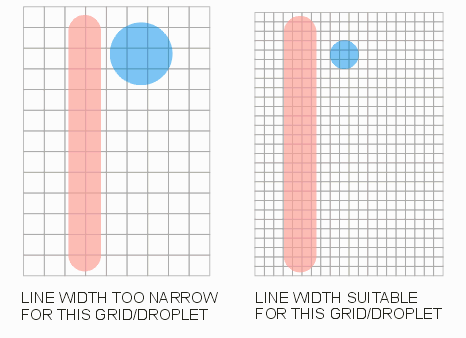Rasterizer Issues for Inkjet Printers
July 30, 2015
Steve DiBartolomeo
Applications Manager
PCB fabricators would like to use industrial inkjets in the production line for both applying photoresist prior to etching and for applying solder mask and solder dams. Stencil fabricators would like to use inkjets in lieu of masks to etch their stencils in order to avoid the cost and time required to produce a film mask.
There are limitations associated with inkjet printers that need to be understood and dealt with if they are to be useful in these manufacturing applications.
These issues include:
Low Resolution
Most industrial inkjets operate in the range of 500 to 2500 DPI. When compared to film masks that are produced at 4000-5000 DPI the ability to control line width and placement is poor. At low resolutions the location of each ink droplet will snap to the nearest grid point. If the bitmap grids are 12.5 um apart then it is clear that the width and placement of 100 um lines will have an inherent uncertainty of 10%.
This amount of variation may be acceptable under some conditions and not acceptable under others. So it is important to understand the application very well if you plan to replace conventional processes with inkjetting.
Ink Droplet Diameter
The diameter of the ink droplet (i.e. after it has landed on the substrate and solidified) needs to be taken into account during the data conversion process. Droplet diameters can be varied considerable (say from about 30 um to about 75 um) but the choice of diameter is constrained by the DPI of the machine. For low resolution DPI's such as 500 (a grid spacing of 50 um) one must have large enough droplets to overlap and assure coverage. This would require a droplet diameter no less than 75-100 um. For finer DPI such as 2500 (grid spacing of 10 um) a droplet of 70 um diameter would generate so much overlap that the excess ink can spread out too far before solidifying.
Narrow Lines and Small Features
When using the terms "narrow" and "small" we mean relative to the droplet diameter. What can happen is that when the boundary edge is shifted inward to account for the droplet diameter the width of the line drops to zero. In that case no droplets are deposited at all. This is normally not what the inkjet user wants. Instead, he prefers that only one (or possibly) two droplets are used - even if this would make the line wider than the design intent.

Adjusting the fill algorithm to recognize these regions and handling them differently that the rest of the geometry can be difficult; not all rasterizers are able to both compensate for droplet diameter and not drop lines or areas that are equal to or smaller than the droplet diameter.
Throughput
When using film masks, the time to "expose" a panel with bank of bright UV lights is measured in seconds. This means you can move a lot of panels per hour through a static exposure machine. The time to "paint" photoresist on the same panel with an inkjet will vary but it is likely to be several minutes on the fast side and could be an hour for very high resolution work. To some extent you have to trade off image resolution against throughput. One can always utilize an inkjet machine with many heads to improve throughput -- though this becomes an expensive solution and has its own issues related to head alignment.
Given the inkjet's native head spacing, to achieve DPIs above 500 generally requires multiple passes and small shifts at least in one axis. An alternative approach is to rotate the head to reduce the effective pitch. Even in the axis of motion, the frequency that one can output droplets may be limited thus forcing the head to travel slower.
Ultimately, certain combinations of image (line) resolution and panel size may not be feasible to run in a production environment using inkjet technology.
Artwork approaches the issues from the view of the software rasterizer used to convert the input vector data (typically Gerber or ODB++ or AutoCAD DXF for stencils) into the bitmap that drives the inkjet. We are working on rasterizer optimizations that produce the best compromise between what is possible and what we send to the inkjet for droplet placement.
The linked pages discuss in more detail the various limitations and how we think best to deal with them.